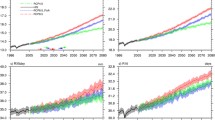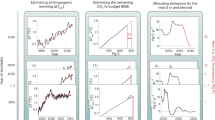Abstract
This paper investigates the potential impacts of alternative international climate change scenarios based on different policies and technological circumstances on future emission pathways and abatement costs. It also examines if these hypothetical scenarios could result in significant emission reductions required to control the global temperature from rising to no more than 2.5 °C above preindustrial level. Using an integrated assessment model, this paper examines these issues under 12 scenarios derived from four policy perspectives and three technology dimensions. Results show that the no-policy-change baseline scenarios lead to high global average temperatures in the future. To control the temperature efficiently, every global region will be required to undertake considerable abatement efforts. Current country pledges alone, even if fully implemented, cannot control the global temperature in the future to within a comfortable zone. There will still be large gap between the reductions needed to meet the 2.5 degree objective, associated with 550 ppm and the reductions associated with existing abatement efforts. Further stringent policies together with favourable technological conditions may lead to the desired level of temperature control. Participation by only a subset of nations not only makes achieving the temperature goal difficult but also costly. To achieve temperature control efficiently, global coordination and full participation by all regions are necessary and global participation may reduce global abatement costs. It is worth noting that abatement costs vary widely across regions under different policy and technology scenarios.


Similar content being viewed by others
Notes
It should be noted that the comparison on the basis on consumption loss may be subjected to bias due to possible distortions resulting from market exchange rate calibration and the influence it has on the value share of energy in various region’s production functions.
References
Baer P, Athanasiou T, Kartha S (2009) A 350 ppm emergency pathway. Stockholm Environmental Institute, Boston
Bosetti V, Carraro C, Tavoni M (2008) Delayed participation of developing countries to climate agreements: should action in the E.U. and U.S. be postponed? Fondazione Eni Enrico Mattei, Working Paper N.70-2008
Caldeira K, Jain AK, Hoffert MI (2003) Climate sensitivity uncertainty and the need for energy without CO2 emission. Science 299(5615):2052–2054
Clarke L, Edmonds J, Jacoby H, Pitcher H, Reilly J, Richels R (2007) Scenarios of greenhouse gas emissions and atmospheric concentrations. Sub-report 2.1A of Synthesis and Assessment Product 2.1 by the U.S. Climate Change Science Program and the Subcommittee on Global Change Research. Department of Energy, Office of Biological & Environmental Research, Washington, DC, 154 pp
Clarke L, Calvin K, Edmonds J, Kyle P, Wise M (2008) Technology and international climate policy. Prepared for the Harvard Project on International Climate Agreements
Edmonds J, Clarke L, Lurz J, Wise M (2008) Stabilizing CO2 concentrations with incomplete international cooperation. Clim Pol 8:355–376 [PNNL-SA-16932]
Edmonds J, Calvin K, Clarke L, Kyle P, Wise M (2012) Energy and technology lessons since Rio. Energy Econ 34:s7–s14
Fisher BS, Nakicenovic N, Alfsen K, CorfeeMorlot J, de la Chesnaye F, Hourcade J-C, Jiang K, Kainuma M, La Rovere E, Matysek A, Rana A, Riahi K, Richels R, Rose S, van Vuuren D, Warren R (2007) Issues related to mitigation in the long term context. In: Metz B, Davidson OR, Bosch PR, Dave R, Meyer LA (eds) Climate Change 2007:Mitigation. Contribution of Working Group III to the Fourth Assessment Report of the Inter-governmental Panel on Climate Change. Cambridge University Press, Cambridge
Ghosh M, Deming L, Muhammad Shahid S, Yunfa Z (2012) Border tax adjustments in the climate policy context: CO2 versus broad-based GHG emission targeting. Energy Econ. doi:10.1016/j.eneco.2012.09.005
Government of Canada (2012) Reduction of carbon dioxide emissions from coal-fired generation of electricity regulations. Can Gaz 146(19)
Green C, Baksi S, Dilmaghani M (2007) Challenges to a climate stabilizing energy policy. Energy Policy 35(1):616–626. doi:10.1016/j.enpol.2006.01.005
Hoffert MI, Caldeira K, Jain AK, Haites EF, Harvey IDD, Potter SD, Schlesinger ME, Schneider SH, Watts RG, Wigleyk TML, Wuebbles DJ (1998) Energy implications of future stabilization of atmospheric CO2. Nature 395:881–884
Hoffert MI, Caldeira K, Benford G, Criswell DR, Green C, Herzog H, Jain AK, Kheshgi HS, Lackner KS, Lewis JS, Lightfoot HD, Manheimer W, Mankins JC, Mauel ME, Perkins LJ, Schlesinger ME, Volk T, Wigley TML (2002) Advanced technology paths to global climate stability: energy for a greenhouse planet. Science 298(1):981–987
Jaeger C, Oppenheimer M (2005) Emissions pathways to avoid dangerous climate change—a trans-atlantic view. SWP Berlin NTACT
Manne A, Richels R (2005) Merge: an integrated assessment model for global climate change. In: Loudon R, Waaub J-P, Zaccour G (eds) Energy and environment. Springer, New York, pp 175–189
Manne A, Mendelson R, Richels R (1995) MERGe: a model for evaluating regional and global effects of GHG reduction policies. Energy Policy 23(1):17–34
National Energy Board (2011) Canada’s energy future: energy supply and demand projections to 2035. NEB
Pacala S, Socolow R (2004) Stabilization wedges: solving the climate problem for the next 50 years with current technologies. Science 305:968–972
Richels R, Rutherford T, Blanford G, Clarke L (2008) Managing the transition to climate stabilization. Clim Pol 7(5):409–428
Rogelj J, McCollum DL, O’Neill BC, Riahi K (2012) 2020 emissions levels required to limit warming to below 2 °C. Nat Clim Chang. doi:10.1038/nclimate1758
UNEP (2010) The emission gap report, are the copenhagen accord pledges sufficient to limit global warming to 2°C or 1.5°C? A preliminary report, November 2010
Weyant J et al (1996) Integrated assessment of climate change: an overview and comparison of approaches and results. In: Bruce JP et al (eds) Climate change 1995: economic and social dimensions of climate change. Cambridge University Press, Cambridge, pp 367–439
Acknowledgments
We are grateful to Christoph Böhringer and Thomas Rutherford for helping us with model development. We thank the three anonymous referees and Derek Hermanutz, Nick Macaluso, Jessica Norup, Julie Vanderschot, Katherine Monahan, Deming Luo, Muhammad Shahid Siddiqui and Cheng-Marshal Wang for insightful comments on an earlier version of the paper. Views expressed in this paper are those of the authors and do not necessarily reflect those of Environment Canada or the Government of Canada.
Author information
Authors and Affiliations
Corresponding author
Additional information
This article is part of the Special Issue on “The EMF27 Study on Global Technology and Climate Policy Strategies” edited by John Weyant, Elmar Kriegler, Geoffrey Blanford, Volker Krey, Jae Edmonds, Keywan Riahi, Richard Richels, and Massimo Tavoni.
Electronic supplementary material
Below is the link to the electronic supplementary material.
ESM 1
(DOCX 32 kb)
Rights and permissions
About this article
Cite this article
Zhu, Y., Ghosh, M. Temperature control, emission abatement and costs: key EMF 27 results from Environment Canada’s Integrated Assessment Model. Climatic Change 123, 571–582 (2014). https://doi.org/10.1007/s10584-013-1002-2
Received:
Accepted:
Published:
Issue Date:
DOI: https://doi.org/10.1007/s10584-013-1002-2




